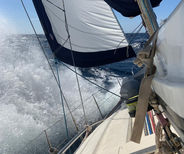YOUR PROGRESS ON THE WATER IS OUR TOP PRIORITY!
TRAINING CONTENT AND TRAINING SEQUENCE
Level of knowledge: all levels of experience, from beginners to prospective skippers. No prior knowledge is required.
Maximum number of participants on training trips: 5
Duration: Usually 7 days, other periods available on request.
Location: Worldwide
Training content
Our training is tailored to the participants’ knowledge and goals. All courses begin with basic boat handling exercises to develop a feel for the boat – an essential foundation for all maneuvers.
Beginners are welcome; no prior experience is needed. Technical terms are explained, and exercises are clearly demonstrated. We then progress step by step to maneuvers such as docking, anchoring, tacking, jibing, hoisting sails, and more.
Advanced participants can take on tasks independently, such as sail handling, maneuvers, or parts of the safety and navigation briefing.
Aspiring skippers can, if suitable and desired, handle all maneuvers themselves,. I am always there to support and only intervene when absolutely necessary
Training procedure
The training week begins at the agreed time with a meeting on board, followed by shopping for provisions. Before departure, a thorough briefing on the boat and safety procedures takes place.
A training day starts after breakfast with a review of the exercises and the planned route. Over 4–6 hours, each participant progresses through step-by-step maneuvers. After lunch, we sail to the next overnight location, using the crossing for additional exercises and to consolidate what has been learned. Often we reach the harbor after dark – a great opportunity to practice night sailing.
The exercises and training days build systematically on one another. Once a skill is mastered, we move on to the next step.
Each participant receives individual feedback as well as confirmation of their nautical miles.
Note: The training content and procedure described above may vary due to weather-related, technical, or organizational factors.





















